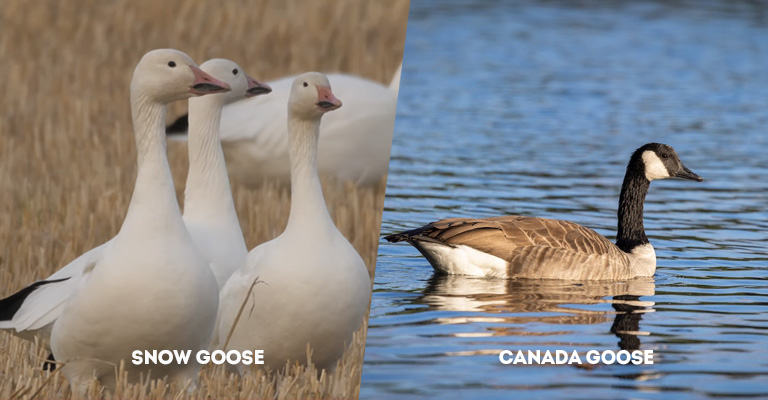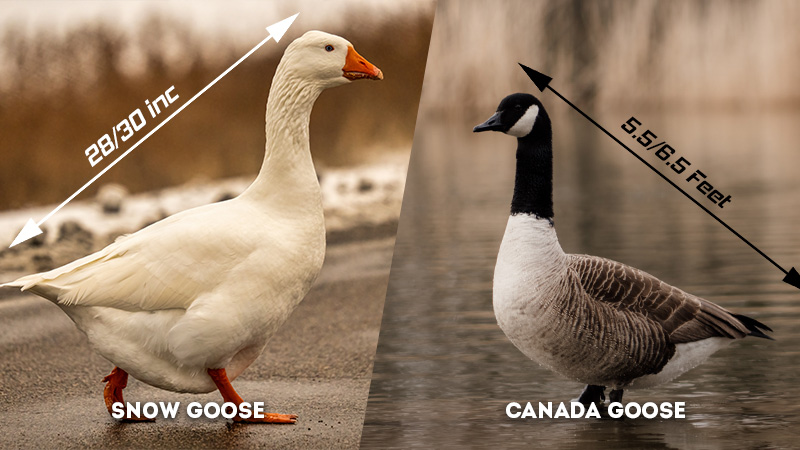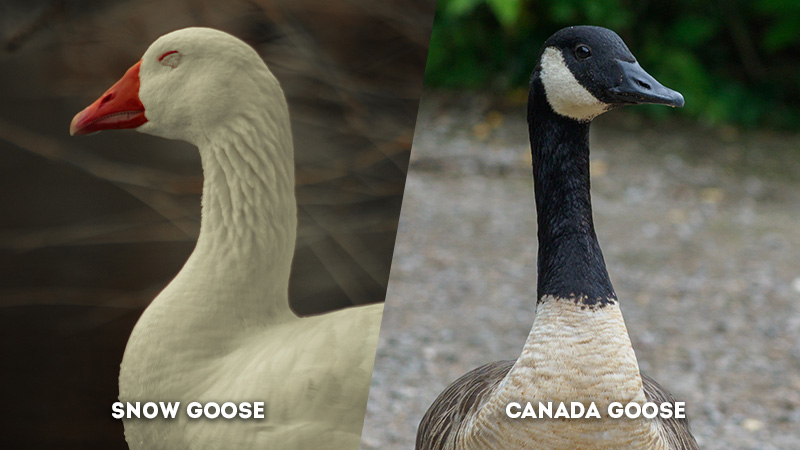Snow geese and Canada geese are two iconic waterfowl species that share habitats across North America. While distinct in their characteristics and behaviors, they both play integral roles in the diverse ecosystems they inhabit.
From their contrasting plumage and migratory patterns to their feeding habits and nesting strategies, these geese offer a fascinating study in adaptability and survival.
Exploring the nuanced differences and unique traits of snow geese and Canada geese provides insights into the dynamic interplay between these birds and their environments, reflecting the intricate tapestry of nature’s diversity on the continent.

Key Differences Between Snow Goose and Canada Goose
Size

- Snow Goose: Snow geese are relatively smaller waterfowl, measuring around 28 to 30 inches in length. They possess a graceful appearance with white plumage and distinctive black wingtips.
These geese come in two subspecies, with the greater snow goose being slightly larger than the lesser snow goose. The greater snow goose weighs between six to eight pounds, while the lesser snow goose weighs approximately five to six pounds. - Canada Goose: In contrast, Canada geese are notably larger, boasting an average weight range of 7 to 14 pounds and a wingspan of 5.5 to 6.5 feet.
These geese have a prominent black head and neck, coupled with a tan to brown body. Their size and distinct coloration contribute to easy identification.
Plumage Differences
- Snow Goose: The plumage of snow geese is characterized by its pristine white coloration, which extends across the body and wings. Their most distinguishing feature is the jet-black wingtips, creating a striking contrast against the white backdrop.
This coloration aids in easy identification, especially during flight. Snow geese exhibit sexual dimorphism, with males and females sharing similar plumage characteristics. - Canada Goose: Canada geese, on the other hand, display a stark contrast in plumage. Their head and neck are predominantly black, while the rest of the body features varying shades of tan and brown.
This distinctive black and tan coloration is a key feature that sets Canada geese apart from other waterfowl species. Furthermore, their cheeks sport white patches that add to their unique appearance.
Bill Color Differences
- Snow Goose: The bill color of snow geese varies slightly between the two subspecies. Greater snow geese typically exhibit a reddish-pink bill, creating an interesting contrast against their white plumage.
This feature is especially prominent during close observations and serves as a distinguishing characteristic. - Canada Goose: Canada geese possess a uniformly black bill that complements their dark head and neck. The consistent coloration of the bill, along with their distinctive head markings, aids in quick identification when these geese are encountered.
Migration Patterns
- Snow Goose: Both snow goose subspecies engage in extensive migratory journeys, making them true symbols of long-distance travelers.
These geese breed in the Arctic tundra and migrate southward during winter to escape the harsh conditions of their breeding grounds.
Their migration often results in the formation of large, awe-inspiring flocks that can be witnessed in various parts of North America. - Canada Goose: Canada geese are also migratory but demonstrate a higher adaptability to urban and suburban environments.
They are known for their distinctive “V” formation during migration, which allows them to conserve energy by flying in an aerodynamically efficient manner.
While some populations migrate long distances, many Canada geese have become year-round residents in areas with suitable food and shelter, making them a familiar sight in urban parks and bodies of water.
Habitat Preferences
- Snow Goose: Snow geese exhibit a strong preference for Arctic breeding grounds, where they nest and raise their young during the short summer season.
In winter, they migrate south to more temperate regions, such as the United States and Mexico. During migration, they can be found in various wetland habitats, including lakes, rivers, and marshes. - Canada Goose: Canada geese are highly adaptable and can thrive in a diverse range of habitats. They are known to frequent urban parks, golf courses, and bodies of water near human settlements.
This adaptability to both natural and human-altered environments has contributed to their widespread distribution.
Behavior in Flight
- Snow Goose: Snow geese are renowned for their spectacular displays of flight behavior, especially during migration. They often form massive flocks that create mesmerizing aerial patterns in the sky.
Their synchronized movements and intricate flight formations capture the attention of observers and photographers alike, making their migration a natural wonder to behold. - Canada Goose: Canada geese also exhibit distinctive behavior in flight, particularly during their migratory journeys.
They are known for flying in a characteristic “V” formation, which enhances their aerodynamic efficiency and allows them to conserve energy during long flights. This formation enables them to navigate challenging weather conditions and cover vast distances.
Feeding Habits
- Snow Goose: Snow geese primarily feed on plant material, including grasses, sedges, and agricultural crops such as grains and tubers.
Their diet is rich in carbohydrates, which provide the energy necessary for their demanding migratory journeys and breeding activities. Their feeding habits can have significant ecological impacts on the areas they visit. - Canada Goose: Canada geese are herbivorous grazers with a diet that includes aquatic plants, grasses, and agricultural crops. They often feed in grassy areas near bodies of water, utilizing their long necks to reach vegetation underwater.
While their grazing behavior can sometimes lead to conflicts with humans, their feeding activities contribute to shaping wetland and grassland ecosystems.
Call Sounds
- Snow Goose: Snow geese are known for producing a variety of vocalizations, ranging from high-pitched, melodious calls to more raucous honks and chattering sounds.
Their calls serve multiple purposes, including communication within flocks, alerting others to potential threats, and maintaining social cohesion during migration and breeding. - Canada Goose: Canada geese are recognized for their distinctive honking calls, which are often heard in flight or when they are foraging. These honks are loud and resonate, allowing geese to communicate with each other over long distances. Their calls also serve as territorial markers and can vary in intensity depending on the situation.
Head and Neck Color

- Snow Goose: Snow geese have uniformly white plumage with black wingtips. Their heads, however, do not exhibit distinct coloration, and their faces lack the prominent black markings found in Canada geese. This creates a more subdued appearance around the head and neck region.
- Canada Goose: Canada geese are instantly recognizable by their black heads and necks. This striking contrast against their tan to brown body makes them stand out among other waterfowl species.
The black and white markings on their faces, including a white chinstrap and patches on their cheeks, further contribute to their unique appearance.
Neck Length
- Snow Goose: Snow geese have relatively shorter necks compared to their body size. This neck length is well-suited for their feeding habits, allowing them to graze on the ground and reach plants in shallow water.
- Canada Goose: Canada geese are characterized by their longer necks, which enable them to reach vegetation both on land and underwater. This adaptability in neck length allows them to forage in a variety of habitats, from grassy fields to aquatic environments.
Breeding Grounds
- Snow Goose: Snow geese breed in the Arctic regions of North America, particularly in the Arctic tundra. These remote and harsh environments provide a relatively short breeding season during the summer months.
Their choice of breeding grounds is influenced by the availability of suitable nesting sites and food resources. - Canada Goose: Canada geese have a more diverse range of breeding grounds. They can be found nesting across North America, from the Arctic to temperate and even urban areas. Their adaptability to different environments allows them to take advantage of a variety of nesting habitats.
Nesting Sites
- Snow Goose: Snow geese often create ground nests in colonies, which can consist of hundreds or even thousands of individual nests close to each other. They choose areas with relatively sparse vegetation in order to have clear lines of sight for predator detection.
The colonies provide a degree of protection through numbers, as more geese increase the chances of spotting and deterring predators. - Canada Goose: Canada geese build their nests near water bodies, including lakes, ponds, rivers, and even urban water features. They construct their nests in sheltered locations, such as on islands or elevated spots near the water’s edge.
These nesting sites offer proximity to their primary food sources and water for both protection and accessibility.
Population Size
- Snow Goose: The population size of snow geese can vary widely based on factors like food availability, breeding success, and habitat conditions.
Their populations can range from relatively small to large, and they are often observed in sizable flocks during migration. - Canada Goose: Canada geese have a relatively stable and abundant population. In some regions, they have become highly adapted to urban environments, leading to locally concentrated populations that are sometimes considered pests due to their interactions with humans.
Conservation Status
- Snow Goose: The conservation status of snow geese is generally secure. However, there have been concerns about overpopulation in some areas leading to habitat degradation and impacts on other species.
Conservation efforts often focus on monitoring population dynamics and managing their interactions with sensitive ecosystems. - Canada Goose: Canada geese are considered common and are not typically classified as endangered or threatened.
However, their adaptability to urban environments can lead to conflicts with humans, particularly in areas where they can cause damage to property or pose risks to aviation safety.
Eating Patterns
- Snow Goose: Snow geese are primarily herbivores, feeding on a variety of plant materials such as grasses, sedges, and agricultural crops. During migration, they often forage in agricultural fields, which can sometimes lead to conflicts with farmers.
- Canada Goose: Canada geese are also herbivores with a diet that includes aquatic plants, grasses, and agricultural crops. They graze in grassy areas near water bodies, as well as feed on submerged vegetation in the water. Their feeding activities can shape wetland ecosystems and sometimes lead to human-wildlife conflicts.
Social Behavior
- Snow Goose: Snow geese are known for their gregarious nature, often forming large flocks during migration and wintering. These flocks can contain thousands of individuals, creating impressive aerial displays in the sky.
Their social behavior provides them with safety in numbers and aids in locating food and suitable habitats. - Canada Goose: Canada geese are also social birds, often seen in family groups. They form strong bonds with their mates and offspring, and these family units can be observed foraging together.
During migration, they fly in “V” formations, which allows them to maintain communication and coordination within the group.
Territorial Behavior
- Snow Goose: Snow geese are less territorial compared to some other waterfowl species. During breeding season, they tend to nest in large colonies, which may give them a degree of protection against predators. However, they focus more on safety in numbers rather than maintaining individual territories.
- Canada Goose: Canada geese are more territorial, especially during the nesting season. They can become aggressive in defending their nesting sites and their immediate surroundings. This territorial behavior is particularly pronounced in urban areas where nesting space can be limited.
Nesting Season
- Snow Goose: The nesting season for snow geese varies depending on their location and subspecies.
Generally, it occurs during the Arctic summer months when the temperatures are milder and snow has melted. This brief window of time allows them to raise their young in the relatively short Arctic summer. - Canada Goose: The nesting season for Canada geese typically spans from spring to early summer. They begin nesting as soon as ice melts from their preferred water bodies.
This timing aligns with the availability of food resources and ensures that their young have sufficient time to grow and develop before migration.
Egg Clutch Size
- Snow Goose: Snow geese generally lay smaller egg clutches compared to Canada geese. Their clutches typically consist of about 3 to 5 eggs. The smaller clutch size may be due to the challenges of nesting in the Arctic tundra where resources can be limited.
- Canada Goose: Canada geese lay larger egg clutches. A typical clutch can contain about 4 to 8 eggs, depending on the subspecies and local conditions. The larger clutch size reflects their adaptability to a wider range of environments and their ability to rear larger broods.
Incubation Period
- Snow Goose: The incubation period for snow goose eggs is around 22 to 25 days. During this time, one or both parents will incubate the eggs, taking turns to ensure the eggs are kept warm and protected.
- Canada Goose: Canada goose eggs have a longer incubation period, usually lasting around 25 to 30 days. Again, the parents share the incubation duties, taking turns to keep the eggs at an optimal temperature for successful hatching.
Snow Goose Vs Canada Goose: Comparison Table
| Key Differences | Snow Goose | Canada Goose |
|---|---|---|
| Size | Generally smaller: 28-30 inches long | Larger: 7-14 pounds, 5.5-6.5 ft wingspan |
| Plumage | White with black wingtips | Black head and neck, tan/brown body |
| Bill Color | Pinkish, sometimes reddish-pink (greater) | Black |
| Migration | Long migratory journeys | Migratory, adaptable to urban areas |
| Habitat | Arctic breeding, southern wintering | Urban, suburban, parks, water bodies |
| Behavior in Flight | Large flocks with impressive displays | “V” formation during migration |
| Feeding Habits | Primarily plant material, grasses, crops | Grazing on grasses and aquatic plants |
| Call Sounds | High-pitched, various calls | Honking calls |
| Head and Neck Color | White with black markings on face | Black head and neck, white cheek patches |
| Neck Length | Shorter neck | Longer neck |
| Breeding Grounds | Arctic regions | North America |
| Nesting Sites | Ground nests in colonies | Nests near water, trees, or structures |
| Population Size | Varies, often in large flocks | Urban-adapted, sometimes considered pests |
| Conservation Status | Secure | Common, some local populations at risk |
| Eating Patterns | Grazing and foraging in fields and water | Grazing in grassy areas, water bodies |
| Social Behavior | Often seen in large groups during migration | Social, forming family groups |
| Territorial Behavior | Less territorial | Can be aggressive near nesting sites |
| Nesting Season | Varies depending on region | Spring to early summer |
| Egg Clutch Size | About 3-5 eggs | About 4-8 eggs |
| Incubation Period | Around 22-25 days | Around 25-30 days |
Frequently Asked Questions
Snow geese tend to create ground nests in colonies, often in open areas, while Canada geese prefer nesting near water bodies, constructing their nests in sheltered locations such as islands or elevated spots near the water’s edge.
Snow geese help shape plant communities by grazing on grasses, sedges, and crops, which can impact the composition of vegetation in their habitats. Canada geese play a role in nutrient cycling by consuming aquatic plants and redistributing nutrients through their waste.
Snow geese rely on their nesting colonies and safety in numbers as a strategy against predators. Canada geese exhibit more territorial behavior, aggressively defending their nesting sites against potential threats to ensure the safety of their eggs and young.
Both geese species have strong flight capabilities, with snow geese forming large flocks that create impressive aerial displays during migration. Canada geese utilize their efficient “V” formation flight, conserving energy and facilitating communication within the flock.
Snow geese use a range of vocalizations, including high-pitched calls and honks, for communication within flocks and alerting others to potential threats. Canada geese are known for their distinctive honking calls, which serve as territorial markers, means of communication, and ways to maintain cohesion during migration.
To Recap
The comparison between snow geese and Canada geese underscores the remarkable diversity within avian species, each finely attuned to its ecological niche.
From the majestic flight formations during migration to their distinct breeding behaviors and habitat preferences, these geese exemplify the intricate balance of nature.
Both species contribute to the intricate web of life, shaping landscapes and ecosystems through their interactions.
Recognizing their unique attributes not only deepens our understanding of avian biology but also fosters a greater appreciation for the harmonious coexistence of these magnificent creatures within the broader tapestry of the natural world.